#Guugu Yimithirr
Text
Languages of the world
Guugu Yimithirr (Guugu Yimidhirr)
Basic facts
Number of native speakers: 810
Spoken in: Australia
Script: Latin, 18 letters
Grammatical cases: 2
Linguistic typology: polysynthetic, SOV
Language family: Pama-Nyungan, Yimidhirr-Yalanji-Yidinic
Number of dialects: 2
History
1770 - Guugu Yimithirr is first written down
1901 - first description of the language
Writing system and pronunciation
These are the letters that make up the script: a b d dh /th dy g i l m n ng nh ny r rr u w y.
Vowels can be short or long. Stress is always placed at the beginning of the word.
Grammar
Nouns have two numbers (singular and plural) and two cases (accusative and ergative).
Guugu Yimithirr is known for its use of cardinal points (north, south, east, and west) to refer to points of location instead of using egocentric directions (forward, backward, right, and left).
Personal pronouns have three numbers (singular, dual, and plural) and can be inclusive or exclusive. Verbs are conjugated for tense, aspect, and number.
Dialects
There are two main dialects: coastal and inland. Originally, Guugu Yimithirr had several dialects.
9 notes
·
View notes
Text
Das Verhältnis zu sich selbst strukturiert das Verhältnis zur Welt: Daniel Haun über Egozentrismus, Sprache und räumliche Orientierung.
0 notes
Text
reminder that many of the artefacts stolen by cook and his crew from Indigenous people of Aotearoa and Australia remain in British hands and have not even been returned to the colonial governments of those countries let alone their original possessors.
the most famous example is the so-called Gweagal shield, taken from a member of the Gweagal clan of the Dharawal Nation during Cook's original landing, alongside several spears. Rodney Kelly, a Gweagal activist, began campaigning for the shield's return to Australia; according to oral histories, Kelly is the descendant of the shield's original bearer, Cooman, who was shot by Cook. the British Museum does not acknowledge these oral histories and considers the question of the shield's ownership to be unresolved.
the spears belonging to Cooman and his compatriot were taken by another member of Cook's crew, and were in the possession of Cambridge University for centuries before being repatriated to Australia and returned to Indigenous ownership in 2023.
a 2016 investigation of the shield concluded it was not the one taken by Cook at his landing - the original shield is now believed to have been lost. this shield, is made of red mangrove wood only found hundreds of kilometres north of Cook's landing site, is now believed to be an artefact of the Guugu Yimithirr people. Kelly and other activists continue to campaign for its restoration as a symbol of Indigenous Australians.
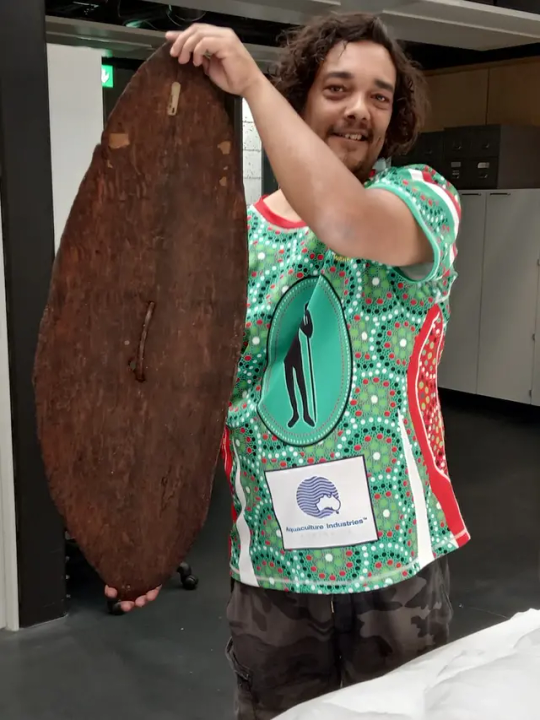
10 notes
·
View notes
Text
A supernatural wife never stays…
I’m always extra fascinated by folklore tropes that show up in a wide variety of cultures, so let’s look at another one: the supernatural/inhuman wife. These are usually stories about a man winning himself a wife that is decidedly not human, either through trickery or courtship. But it never lasts, because these stories all seem to have the same ending, the wife leaves:
Almost all selkie stories, both from Celtic and Nordic tradition, are an example of this. A man steals a selkie’s pelt and thereby binds him to her or leaves her stranded on land and in her desperation persuades her to come back with him and become his wife. After many years and many children she always finds her pelt, however, and as soon as she does she runs off to the sea. In most cases it turns out she has a husband and children in the sea too. In most she keeps leaving presents for her children and in some she still feels affection for her human husband, but she never goes back ashore. There are similar tales about swan-maidens.
An Aboriginal story from the Guugu Yimithirr-speaking people called “The forest spirit and his ten beautiful daughters” tells how the great hunter and warrior Gabul, the Carpet Snake, goes to the mountaintop where the powerful Forest Spirit, lives. He bests him in an unarmed fight, demanding to marry one of his daughters as reward before he will let him go. He takes the most beautiful of the ten daughters home to be his wife but starts worrying when she does not eat or drink. Eventually he takes her to the river and there she promptly turns into a fish and swims upstream back to her father’s mountain, leaving Gabul ashamed and broken-hearted.
There are also stories about fairy wives, most notably two from Wales. One, collected as “The Shepherd of Myddvai”, has a shepherd courts a beautiful maiden that dwells in a lake by bringing her bread. She agrees to go with him if he promises not to strike her three times without cause. Of course he promises this, but he taps her once for dallying to spur her into action, once in confusion when she weeps at a happy wedding, and once in disapproval when she laughs at a sober funeral. She declares their marriage ended and flees back to her lake, only returning once her sons are grown to give them gifts of healing.
In the similar tale “Touched by Iron” a farmer’s son falls in love with a fairy maiden and the promise he must make her father is to never touch her with iron. One day as he helps his wife off her horse, she is touched on the knee by the stirrup of the saddle and vanishes. But with her mother’s help she does get to visit him sometimes afterwards, by standing on a large floating turf on a lake, so it could not be said she had set foot on human earth.
In a Chinese story called “The Painter”, from the 9th century bundle Wenqi lu, a learned man buys a screen with a painting of an inhumanly beautiful woman on it. The painter tells him of a ritual that might bring the woman to life and the man manages to call her to him. She steps out of the painting and consents to stay with him, they even have a son together. When the child is two years old, however, the man speaks with a friend of his, who immediately suspects the woman of being a dangerous creature and gives him a celestial weapon to kill her. As soon as he arrives home, his companion sobs that she is a mountain spirit who never asked to be painted by the painter and never asked to be called by him. She steps back into the painting, taking her child with her, leaving the man alone with a beautifully painted screen that now shows both her and the little boy.
#another little roundup#because I haven't got the brain to create my own fiction#laura babbles#folklore#fairy tales#welsh folklore#chinese folklore#celtic folklore#scandinavian folklore#aboriginal folklore
226 notes
·
View notes
Note
Heya I'm bored so like, what's yoir current favorite animal? Mines the olm
Ahhhh I love them all it's hard to choose... Sooo I'll say my top 2
The spotted tiger Quoll
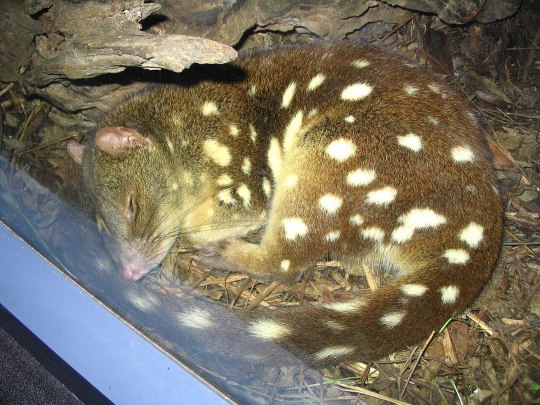
(Pictured: A spotted tiger quoll, Dasyurus maculatus, curled up sleeping in a glass exhibit.)
Bunjeen is the original Indigenous name (from the Bandjalung language group) for them in my area. Was called the marsupial cat by colonizers until naturalist told folk or was missleading. "Quoll" comes from anglicisation of "dhigul" (Note: Aboriginal spelling is different from English spelling) from the Guugu Yimithirr mob who contacted Captain Cook (our Christopher Columbus booooo).
Since it occupies the same ecological niche as them. A good native defence against feral rabbits, but is vulnrable due to competition with feral cats and poisoning from cane toads. These Polka dotted murder balls are the second largest extant carnivorus marsupial. Live only for 2-4 years. The size of a grain of rice when born. Live solitarily, but will use a communal latrine to see who's in the area. Reaches it's teens in year one, stops growing year two, doesn't live very long past year 3 (;TДT). I don't like exotics, and the reality is definetly different to my fantasy, but I kinda want one as a pet. Maybe I can volunteer at a sanctuary or something.
(Pictured; A Spotted-tailed Tiger Quoll on a mossy log at night, by JJ Henson.
Below that picture is an Eastern Quoll, Dasyurus viverrinus. Eating a very bloody piece of meat with their hands full. I had to include it for the absolute gremlin energy).
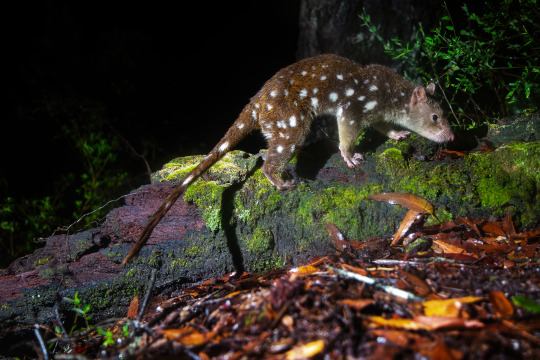

Hoatzin
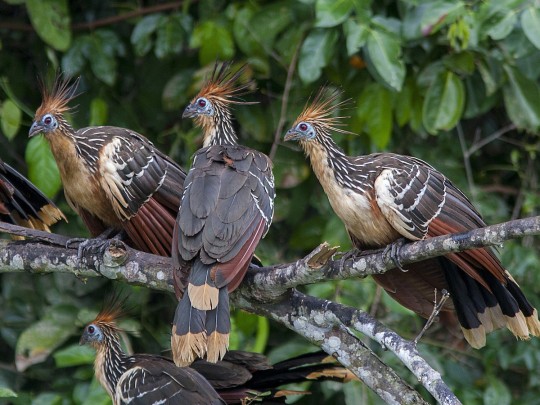
Stem-bird/Dinosaur vibes. Babies have claws on their wings to climb trees if they fall out of the nest. It is also the only bird to be a folivore; a dedicated leaf eater (foli, like foliage, and vore, which I encourage everyone to look up themselves). It's very rotund for digestion and stinky, like a cow! A dinosaur cow bird is also apt, because we no idea what kind of bird it is! Is it a pheasant? Ratite? Songbird? To my understanding, the current idea is that it's a survivor of a unique lineage of birds that survived the Chicxulub mass extinction. Our oldest fossils of potential relatives only go to about 30 MYA. Not even genetics have gotten us too far, but give it time. Was my profile picture for a time on an obscure internet forum when I was a teen. It is also the same colours as my favourite and oldest Velociraptor plush toy. (Razor the wild republic UK Velociraptor plush)


(Pictured; Top Picture of a Hoatzin chick with visable wing claws. Below it Razor, my Willd Republic UK Velocirptor)
#Bandjalung#Bandjalung language#Indigenous languages#Aboriginal language#Inidgenous language#Aboriginal Australia#Bunjeen#tiger quoll#spotted-tail quoll#Dasyurus maculatus#Quoll#Dasyurus#marsupial#mammal#Hoatzin#Opisthocomus hoazin#Opisthocomus#aves#birds#metazoa#animals#plush#Wild republic#wild republic velociraptor#plushies#velociraptor#This was meant to be a quick summery but I spent 3 hours doing background research on these guys woops
8 notes
·
View notes
Text
Sooooooo, a lot has happened. I want to start diarising again.
I now am fairly confident and secure in my identity.
Whew.
I am a queer Demigirl, Intersectional environmentalist feminist, AuDHDer, humbled to be living on Gungardie, home of Guugu Yimithirr, sovereignty never ceded.
I am sole parent warrior to a blak 8 year old soul AuDHDer, who is bravely discovering their own identity and what that means for them.
I am striving to achieve balance, in my internal world and in the world at large.
I feel intensely passionate about equal rights, for all who require to share this galaxy, and to keep the balance right in the universe as a whole.
It is so incredibly relieving to understand myself better. This does not mean I do not struggle.
Unlocking my life has also made me understand that emotions can be overwhelming, and holding emotion and trauma in the body can make you feel horrible, for very very long periods of time.
But I am willing to feel the emotions. I need to understand them and sit with them, whilst also learning how to release them.
Slowly, slowly, small changes slowly. For all of you who know me you will know this isn't who I am.
Until next time
0 notes
Text
Wir besuchen Cooktown im äußersten Norden von Queensland, wo Kapitän James Cook sein havariertes Schiff auf den Strand setzte und dabei half, ein riesiges Land zu gründen
Wenn Sie eine Karte von Australien gesehen haben, haben Sie die riesige, abgelegene Kap-York-Halbinsel gesehen, ein Gebiet, das größer als Großbritannien ist, aber nur 18.000 Einwohner hat. Die Halbinsel Cape York, die den nördlichsten Punkt Australiens beheimatet, zeigt nach oben in Richtung Torres Strait und Neuguinea in der nordöstlichen Ecke der kontinentgroßen Insel Australien.
Am südöstlichen Rand der rund 2.600 Einwohner zählenden Halbinsel liegt Cooktown, eine Kleinstadt mit großer Geschichte. Während unserer Kleinschiff-Expedition rund um das Great Barrier Reef mit Coral Expeditions machten wir einen Vormittag.
Atlas & Boots Blick über das Wasser von Cooktown
Als Erkundungs-Junkie, der von Karten, großartigen Expeditionen und epischen Entdeckungsreisen besessen ist, war ich nur zu erfreut, das legendäre Land von Cooktown zu betreten.
Großer südlicher Kontinent
Leutnant James Cook stach 1768 als Kapitän der HMS Endeavour, einem umgebauten Kohleschiff, von Plymouth, Großbritannien, aus in See. Es war die erste seiner mittlerweile vier legendären Reisen in den Pazifischen Ozean. Das knapp 30 m lange Schiff beförderte 93 Mann nach Tahiti. Ihre Mission: den „Transit der Venus“ zu beobachten.
Die Endeavour trug weitere „geheime“ Anweisungen, um „einen Kontinent oder ein Land von großer Ausdehnung“ in Besitz zu nehmen, von dem angenommen wird, dass es in den südlichen Breiten existiert. Cook wurde beauftragt, den sagenumwobenen – aber unerforschten – großen südlichen Kontinent zu entdecken.
Im Oktober 1769 erreichte die Endeavour die Küste Neuseelands und war damit das erste europäische Schiff seit Abel Tasmans Heemskerck im Jahr 1642. Das Schiff fuhr weiter nach Norden zu dem, was damals als Terra Australis bekannt war.
Atlas & Boots Ein Modell der HMS Endeavour
Am 29. April landete die Endeavour als erstes europäisches Schiff an der Ostküste Australiens. Cook landete an der Südküste der heutigen Botany Bay in Sydney.
Die Endeavour fuhr weiter nach Norden und segelte entlang der Ostküste Australiens. Das Schiff und seine Besatzung entgingen nur knapp einer Katastrophe, nachdem sie am Great Barrier Reef auf Grund gelaufen waren.
Nachdem sie Waffen und Vorräte abgeworfen hatte, um das Schiff zu erleichtern, gelang es der Besatzung, die Endeavour zu befreien. Nur eine Woche später setzten sie das Schiff am 17. Juni 1770 an der Mündung des späteren Endeavour River an der Stelle des heutigen Cooktown auf den Strand.
Cook und seine Crew blieben 48 Tage vor Ort, während sie Reparaturen durchführten. Hier trafen sie auf den Stamm der Aborigines Guugu Yimithirr, was zum ersten dokumentierten bedeutsamen Kontakt mit Australiens Ureinwohnern führte.
Am 19. Juli 1770 traten sie ihre Rückreise nach Großbritannien an und erreichten nach fast drei Jahren auf See am 12. Juli 1771 die englische Hafenstadt Dover.
Kochstadt heute
Heute macht Cooktown das Beste aus seiner maritimen Geschichte mit dem herausragenden James Cook Museum im Zentrum. Das Museum ist in einem wunderschönen, 1899 erbauten ehemaligen Kloster untergebracht und zeigt gut erhaltene Relikte, darunter die Kanone und den Anker der Endeavour – die 1969 von einem amerikanischen Forschungsteam geborgen wurden – sowie Tagebucheinträge und Ausstellungen über die lokale indigene Kultur.
Wir verbrachten eine Stunde damit, durch die Räume des kleinen Museums zu wandern, fasziniert von den dargestellten Geschichten. Besonders überzeugend sind die Auszüge aus Cooks Tagebüchern. Sie beschreiben das erste Treffen seiner Crew mit dem Stamm der Aborigines Guugu Yimithirr sowie die Scharmützel und die Versöhnung vor der Abfahrt des Schiffes. Es gibt auch einen Bericht über Cooks Leben in einer Reihe von Tafeln an den Wänden.
Andere Galerien beherbergen Gegenstände von den Schülern und Nonnen,
die das Kloster einst ihr Zuhause nannten, Geschichten aus dem Palmer-Goldrausch und eine Ausstellung, die dem chinesischen Erbe der Region gewidmet ist. Die Indigenous Gallery bietet einen faszinierenden Einblick in die Kultur und Geschichte der Guugu Ymithiir, insbesondere in ihre Perspektiven der Begegnungen mit Cook und seiner Crew.
Entlang der Uferpromenade befindet sich der Bicentennial Park, der mit Gedenken an die historische Landung übersät ist. Dazu gehören die viel fotografierte Bronzestatue von Captain Cook sowie ein zweites Denkmal, das vor über hundert Jahren errichtet wurde. Die hohe Sandsteinsäule und die Gedenktafel erheben sich von einem quadratischen Sockel, der auf jeder Seite Trinkbrunnen enthält. Draußen im Wasser befindet sich auch ein Felsen, der die Stelle markiert, an der die Endeavour auf Grund gelaufen ist.
Atlas & Boots Die Bronzestatue von Captain Cook
In der Nähe befindet sich die Milbi Wall, eine 12 m lange Mosaikinstallation, die die Geschichte des lokalen Aborigine-Stammes Guugu Yimithirr darstellt. Die in drei Teile gegliederte Installation zeigt die Entstehungsgeschichten des Endeavour River und seiner Umgebung, das erste Treffen zwischen den Ureinwohnern der Kap-York-Halbinsel und den Europäern sowie das Referendum von 1967, als die Australier die Rechte der Ureinwohner anerkannten.
Es lohnt sich auch, beim urigen und charmanten Postamt vorbeizuschauen, um eine Postkarte mit einer Briefmarke zum Thema Captain Cook (was sonst!) zu verschicken. Das Postamt wurde 1880 gegründet und dient gleichzeitig als Sitz des Australian Bureau of Meteorology für die Region.
Schließlich gibt es noch den Grassy Hill Lookout, den 162 m hohen Hügel, den Cook auf der Suche nach einer sicheren Passage durch die Riffe bestiegen hat. Hier fand die erste dokumentierte europäische Sichtung von Kängurus statt. Der Wissenschaftler Joseph Banks zeichnete die Tiere in seinem Tagebuch als „Gangurru“ auf, die er als „Känguru“ transkribierte. Der 360-Grad-Blick auf die Stadt, den Fluss und das Meer ist den 20-minütigen Spaziergang von der Stadt wert.
Wir sind nach Queensland gefahren, um am Great Barrier Reef zu tauchen und zu schnorcheln, aber in Cooktown an Land zu gehen, in die Fußstapfen der Legende zu treten, etwas über seine einzigartige Geschichte zu erfahren und durch die hübsche Stadt zu schlendern, war ein faszinierender Abstecher vom rollenden Korallenmeer.
Atlas & Boots
Cooktown erkunden: das Wesentliche
Was: Erkunden Sie Cooktown, den historischen Landeplatz von Captain Cook in Australien.
Wo: Wir haben auf Coral Expeditions II in einer Kabine auf dem Oberdeck übernachtet. Unser Zimmer war äußerst komfortabel und überraschend geräumig mit viel Stauraum und einem atemberaubenden Meerblick.
Atlas & Boots
Aperitifs wurden auf dem Oberdeck serviert und die Mahlzeiten wurden im Speisesaal des Unterdecks eingenommen, wo Küchenchef Mark Festmahle zum Frühstück, Mittag- und Abendessen sowie Morgen- und Nachmittagstee zubereitete.
Die maximale Kapazität von 44 Gästen (unsere hatten 22) sorgt für eine hervorragende Kameradschaft und Atmosphäre, die durch eine entzückende Crew noch verstärkt wird. Insgesamt war es eine wunderbare Art, das Great Barrier Reef zu erkunden.
Wann: Die beste Zeit, um Cooktown, Queensland und das Great Barrier Reef zu besuchen, ist von Juli bis Oktober wegen guter Sichtverhältnisse und wenig Regen und Wind.
Wie: Wir haben uns Coral Expeditions für eine 7-Nächte-Expedition von Cairns nach Hinchinbrook Island, Lizard Island und zurück nach Cairns angeschlossen.
Die Preise beginnen bei 3.680 AUD (2.720 USD) pro Person und beinhalten alle Mahlzeiten, Tee und Kaffee, Schnorchelausrüstung und Neoprenanzüge, Schnorchelausflüge, geführte Fahrten mit dem Glasbodenboot, Präsentationen von Meeresbiologen, Zugang zu Inseln, Meeresparks und Nationalparks, an Einführung in die Tauchfertigkeiten für Ersttaucher und Rücktransfer zu einem Hotel in Cairns oder zum Flughafen Cairns.
Die Preise beinhalten keine Tauchgänge ($80 AUD / $60 USD pro Person, pro Tauchgang) oder Stinger Suits. Beachten Sie, dass es an Bord keinen Internetzugang gibt.
Expeditionen starten und kehren zum Cairns Cruise Liner Terminal zurück. Sie erhalten vor der Abfahrt Anweisungen zum Einsteigen, die es wert sind, sorgfältig gelesen zu werden, da Taxifahrer nicht immer genau wissen, wohin sie fahren müssen.
Cairns selbst kann mit dem Auto von Hertz Australia, mit dem Bus von Greyhound Australia oder mit dem Flugzeug zum Flughafen Cairns erreicht werden. Buchen Sie Inlands- oder Auslandsflüge über Skyscanner zu den besten Preisen.
Lonely Planet Australia ist ein umfassender Reiseführer für das Land, ideal für diejenigen, die sowohl die wichtigsten Sehenswürdigkeiten erkunden als auch weniger befahrene Straßen nehmen möchten.
Offenlegung: Wir haben das Great Barrier Reef mit Unterstützung von Coral Expeditions erkundet. Alle Publikationen sagen das, aber wir garantieren wirklich keine positive Berichterstattung. Wir sagen, was wir denken – gut und schlecht – damit Sie mit ehrlicher Beratung fundierte Entscheidungen treffen können.
Leitbild: Public Domain
.
#Australia#Ozeanien#Captain#Cook#Cooktown#Erbe_Ruinen#Erkundung#Forscher#Great_Barrier_Reef#historischen#Kultur#Landeplatz#Meere_Ozeane
0 notes
Text
Notes on Learning a New Language
Greetings
It was June of 2017 when I first met J. That was also the last night I spent in UP before moving to Mindanao, where I would spend the next five years, although I didn’t know it at the time. We had actually talked before, briefly. We met up in Palma Hall where he gave me a pirated copy of Breaking Bad, but he was in a hurry then, on his way to a meeting in Maginhawa. I didn’t ask him particularly for a copy, but he was kind enough to go to UP even if it meant taking a small detour. Even then, I realized he was the kind of person who would make time for others.
J had come from an Independence Day mob in Ayala. I saw him just outside Ministop Maginhawa, in shorts, sandals, and a black t-shirt—typical mob attire. He stood at exactly six feet; I remember him telling me. As always, he had gone out of his way to keep me company on my last night in UP before my flight to Davao. He had nowhere else to go, he told me, since his dorm had a 10-pm curfew (we had met up at around 9 pm), and besides, he added, we needed proper introductions.
And so it was that we spent the entire night swapping life stories on a stone bench in front of Vinzons, sharing a pack of cigarettes. I had unfortunately forgotten what we talked about, what trivial piece of information about my life I had left him with. I do remember the look of utter surprise on his face when I told him I was leaving him with all my books. He said a book was like a piece of someone’s heart, and so giving and receiving books was a very intimate act of exchanging parts of ourselves. You can imagine his astonishment and delight when I left with not one, but a duffel bag full of books I had collected over the years. For him, I had already given my entire heart.
A few days after that night, and for all the days and nights to come while I was in Mindanao, I arrived in Davao City, thinking how J would have loved it here. Since that night, everything I’ve done has been with J in mind, as ridiculous as it might sound. For instance, I learned that “magandang umaga” in the language of the Manobo tribe of Davao-Bukidnon is mowpiya no masolom if they are Matigsalug, or maradyow no masolom if they are Matigtalomo. “gabi” in Manobo is marokilom; “hapon” is mohapon. The greetings would adjust accordingly. Manobos distinguish themselves according to the river their ancestors had come from. The Matigsalug tribe live along the banks of the Salug River, flowing through southeastern Bukidnon towards Davao City. The Matigtalomo are mostly found in Talaingod, Davao del Norte. J would have loved that idea—water separating the languages we grow up in, whether it was a river or a sea, yet somehow still making ourselves understood despite the distance. He grew up in Zambales and was introduced to the sea at a young age.
Geography, Wildlife
I recently read about a tribe of aboriginal Australians, the Guugu Yimithirr, whose native language primarily uses cardinal directions—north, south, east, and west—to locate themselves and everything around them, giving them a near-precise sense of direction. How useful it would be to never lose your bearings, no matter where you might find yourself. My first few months in Bukidnon were some of the most difficult. I didn’t know any Binisaya, and neither did my comrades, who were mostly Manobos. They could understand Tagalog, mostly thanks to old Pinoy action movies they enjoyed watching. Tagalog and Manobo have very few words in common. I can recall only two, which are, interestingly enough, “paa” (foot) and “dagat” (sea).
I eventually developed a fear of getting lost. To put my mind at ease, to find my bearings if I ever got lost in the mountains, I learned as many words for land markers as I could. Wohig is a river, however wide or shallow it is. A mountain is called bobongan. It is easy to walk on napo, flat plains. My comrades used to ask what it was like living sa dibabo, in the flat, lowland plains through which all rivers flowed on their way to the sea. Sampow is a waterfall; powalas is a forest. My favorite, because it is the most recognizable, is sabang, the point where two smaller rivers converge into one, and is thus given one name.
Aside from geography, I learned a great deal of wildlife. What continues to fascinate me is the fact that Manobos have a name for every bird they encounter. There is the salapati, a dove. A kalasanon, a wild chicken, can be very jarring to hear in the middle of a forest. A saguksok got its name from its distinctive call, which sounds exactly like “sa!-guk!-sok!”. The locals often lament about the kalyawa, whose cries used to fill the forests near their homes. Rigoy, a comrade of mine who died of tuberculosis, often imitated the call of the salapuyan. It has a low, lonely, drawn-out call. Wandering through the forest, I would always mistake it for a dog’s whimper. I like to believe he was talking to the birds, divulging all his secrets.
Verbs
The limokon resembles a pigeon—plump and small, with gray-brown feathers, red feet, and a red beak. Its breast has an iridescent plumage, now maroon, now green. It has a distinct call, starting out as low and slow hoots, eventually going faster, like a hand rapping on a wooden door, insistent and thoughtful at the same time. It is perhaps for this reason that the limokon figures as an omen bird in Manobo superstition. When one hears a limokon’s call ahead of him while walking, he must immediately return to where he came from, for whatever lies ahead will bring him danger and bad luck.
The mountains of the Pantaron range in Talaingod are harsh for the uninitiated and unfamiliar. Pantad is “sand” in Manobo, loose, treacherous earth. It took me years to master the principle of walking like my comrades do; even five years later I am still as clumsy as ever. They, on the other hand, almost floated on the earth. If learning to walk was hard enough, I had to master running, climbing, hiding, and generally living in the mountains. Ogpa is to live. Ondoi kad og ogpa? means “where do you live?” Makati and UP and even J all seem farther than ever, which is ironic since I can now simply purchase a ticket and not worry about any danger along the way. Gipanow is to walk, palagoy to run, and holos to hide. There are two words in Manobo for fording rivers, it reminds me to always be mindful of where I’m going: uraek is to ford a river upstream and laras is to ford downstream. Nabuntol is tired; gimoloy is to rest. I don’t think Manobos believe in the afterlife. When someone dies, the people they leave behind remark, “nakagimoloy on.” At least, nakapahinga na.
“I love you”
Tita R was the mother of one of my comrades, the only other city-raised bourgeois intellectual who lasted almost as long as I did in the mountains. She says she missed me, and is glad not because I am alive, but because I am still alive despite everything that has happened. Sometimes I feel I should not share in her or anyone else’s happiness about my continued survival.
When learning a language, almost always the first thing we learn is how to say “I love you” in that language. We believe the people we love deserve to hear it in all tongues; naturally I’ve told J this, since he enjoys language and its nuances and possibilities.
“Ginhawa” in Tagalog means “relief.” But “ginhawa” in Binisaya, and its Manobo translation goynawa, means “breath.” Beyond breath, Manobos use the word goynawa to describe the heart of hearts, that part of us only the people we truly love can touch and hurt and caress. In times of distress, when a loved one has caused pain, they lament, masakit ka kodi no goynawa. In Manobo, “I love you” is dakkol goynawa ko keykow. In my own translation, I say, my heart has grown; it is for you.
0 notes
Text
Fun Facts About Kangaroos
The kangaroo is one of the most common Australian mammals. This solitary mammal lives in parts of the eastern third of the continent. It feeds mainly on grasses, especially young ones, that are high in protein. It will occasionally inhabit forests, but prefers drier regions. The kangaroo needs little water, as it gets enough moisture from its diet. As such, it rarely needs to seek out water in the wild.
The word 'kangaroo' is derived from the Guugu Yimithirr language, 'gangurru'. It was first recorded as 'kanguru' on 12 July 1770, when the HMS Endeavour was beached at the site of modern-day Cooktown. Cook's crew was repairing damage to the Great Barrier Reef at the time, and in a diary entry on 4 August, Lieutenant James Cook first mentions the kangaroo.
The kangaroo's limbs are made of three bones: the femur and the tibia. The tibia is double the size of the femur, and its "z"-shaped hind legs act like giant springs. In a single bound, a kangaroo can jump thirty feet. Its front legs are also strong enough to serve as a third leg.
Various species of kangaroos have different diets. Eastern grey kangaroo is a grazer, while the red kangaroo is an omnivore that eats trees and shrubs. It also eats fungi, which are called hypogeal. Several species of kangaroos are crepuscular and nocturnal, and spend their cool evenings moving.
Red kangaroos are perceived by farmers and graziers as pests. Their problems include competition with livestock and damage to crops and fences. Licensed shooters have been designated to kill kangaroos and keep them from invading the countryside. A quota for culling is set every year based on aerial surveys of kangaroo populations. Many of these kangaroos are harvested for their meat.
Female kangaroos usually give birth to one young every year. The young joey is about 2 centimeters long and weighs less than a gram. It crawls up its mother's body to her pouch and attaches its mouth to her teats. The pouch remains closed for the first 120 to 450 days. After this time, the joey will leave the pouch.
Red kangaroos live in mobs of around ten to fifteen individuals. Males are seldom present in these mobs. Some groups can contain up to 1,500 individuals. Most red kangaroos spend their active time grazing in the shade and resting in the morning and evening. They will stamp their feet to warn others and enter their pouches. If they are attacked by a predator, they will immediately attack it and cause an injury.
The kangaroo has a tail the length of its body, and it acts as a massive rudder when it hops. The kangaroo can even rock back on its tail while delivering powerful kicks with both legs at the same time. The kangaroo's hind legs are attached so that it can move them together and separately. They can jump over tall trees and climb near vertical slopes.
https://youtu.be/hGaEP03xVA8
Additional Resources:
Horses
Dogs
Cats
Tigers
Maned Wolf
Moon Bear
Tarsiers
Tibetan Mastiff
Read the full article
0 notes
Text
14 Indigenous Words for Money on New Australian 50c Coin
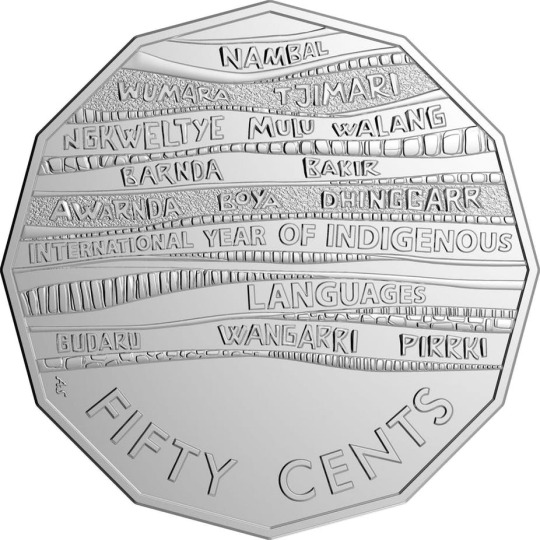
To celebrate International Year of Indigenous Languages, the Royal Australian Mint launched the new coins.
Money, or an object which abstractly represented the value of goods and services, did not exist in Australia before European colonisation. Trade occurred, but it was between items deemed to be of similar worth, for example, pearl shell, quartz, food or songs. With the entry of money into the Indigenous economy, new words were needed to refer to coins and later, notes.
Most Indigenous words for money come from words for “stone”, “rock” or “pebble”, no doubt in reference to the size and shape of coins. On the new 50 cent coin, you’ll find words for “stone” from across Australia:
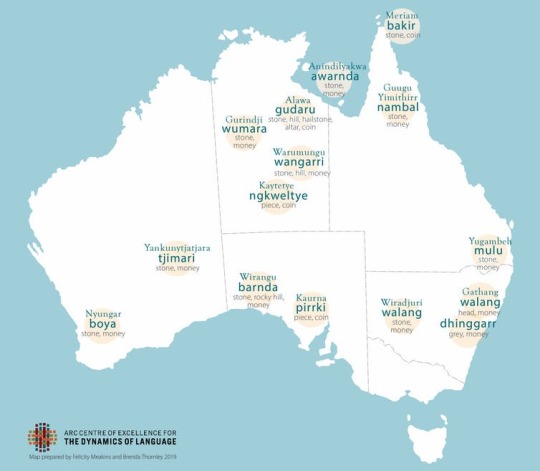
Source
#indigenous languages#aboriginal languages#gurindji#warumungu#alawa#anindilyakwa#nyungar#yankunytjatjara#meriam#yugambeh#guugu yimithirr#gathang#kaytetye#kaurna#wiradjuri#wirangu
367 notes
·
View notes
Photo

A Year in Language, Day 18: Guugu Yimithirr
Guugu Yimithirr, whose spelling can vary quite a bit depending on your source, is a language spoken by an Australian Aboriginal tribe of the same name in Far North Queensland. It belongs to the Pama-Nyungan language family, as do almost all Autralian Aboriginal languages.
This languages claim to fame is as the source of the word "kangaroo". Despite urban legends that this word translates to something like "what are you asking me, white man?" it is actually the name for the animal, though in Guugu Yimithirr it refers to just one variety of kangaroo.
The name of the language actually means "language that has "yimi"". "yimi" is the Guugu Yimithirr word for "this" and apparently that fact was considered distinctive about them. We'll likely see a similar style of name next time I cover an Aboriginal language.
As is true for many Aboriginal language Guugu Yimithirr lacks any fricative consonants; no "s", "f", "sh" and so on. Another feature it lacks, at least prior to colonization, are any words for egocentric coordinates. These are words like "left", "right", "forwards" and "backwards". So in Guugu Yimithirr your western leg might be sore today, at least until you turn and it becomes your northern leg.
49 notes
·
View notes
Text

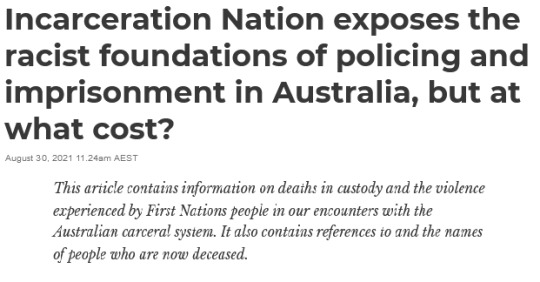
“They killed him.”
David Dungay Jr died in Sydney’s Long Bay prison in 2015. In the opening scene of the documentary Incarceration Nation, Dunghutti woman Aunty Leetona Dungay, David’s mother, sets the scene for what viewers are about to witness.
While David Dungay’s family’s campaign was not discussed in depth in the documentary, there’s no question why they have lodged a complaint with the United Nations Human Rights Committee to seek accountability for the guards involved in his death. David Dungay’s death is one of about 500 Aboriginal deaths in custody since the Royal Commission report was released in 1991. No one has ever been held accountable for these deaths.
Directed by Guugu Yimithirr man Dean Gibson, Incarceration Nation is relentless and emotionally demanding of its audience. This is due to scenes of explicit violence perpetrated against Aboriginal and Torres Strait Islander people - especially children - by those in authority. It might be one of the most disturbing things you ever watch. [...]

First Nations people make up 3.3% of Australia’s population. Yet 65% of children incarcerated in this country between the ages of 10 and 13 are Aboriginal and Torres Strait Islander. First Nations children make up 55% of the child prison population overall. Aboriginal women, the fastest growing prison population, make up 34% of those incarcerated in women’s prisons.
While these statistics are often used by criminologists and the state to represent the problem as one of “over-representation”, in reality they reflect the colonial function of incarceration in the Australian settler colony — to further the erasure of First Nations people. These statistics are increasingly recognised as a serious breach of human rights internationally.
Yet in Australia, despite demands from First Nations communities to prioritise decarceration and community-based responses to ensure our safety, state and territory governments continue to prioritise carceral expansion. There are even plans to build more prisons and increase policing resources.
Keenan Mundine, co-founder of Deadly Connections, an Aboriginal community-led organisation that provides services to First Nations people impacted by child removal and carceral systems, responds to the issue of underfunded Aboriginal community organisations and increasing police budgets in the documentary:
[police have] been given more resources and more funding, to do what they do best, which is terrorising Aboriginal communities.
Incarceration Nation weaves together historical records, archival footage, statistics, expert advice, and the testimonies of individuals with lived experience and families who have lost loved ones in custody. For First Nations viewers and our advocates, aspects of this documentary stand within a powerful apparatus to expose the systemic, colonial underpinnings of Australia’s “justice” system. [...] For this documentary to move beyond identifying this problem - one consistently highlighted by First Nations people and communities - it requires non-First Nations people, particularly white people, to change.
Change will not be achieved through reform, but through the abolition of the colonial system [...]. From the views expressed by many First Nations people in Incarceration Nation, including public servants, it is clear that expectations of policies and programs to ensure “stronger” relationships between Aboriginal people and police have lapsed. What is being requested now is that policing and imprisonment be overhauled and dismantled.
Trusting in carceral reforms alone is, in fact, a dangerous solution. As Yuin Aunty Vickie Roach, an advocate for prison abolition, highlights in the documentary, it is not possible to fix a system that is not broken, but rather operating exactly as it was designed to do.


-------
Headline, subheadings, graphics, and all text published by: Latoya Aroha Rule, Lilly Brown, and Natalie Ironfield. “Incarceration Nation exposes the racist foundations of policing and imprisonment in Australia, but at what cost?” The Conversation. 30 August 2021.
357 notes
·
View notes
Text
thank you @genderretired and @carpe-noctium for unintentionally reminding me that i had plans to make a post about weaving and stuff and got distracted
the are under a read more because i may have gotten a tad bit over enthusiastic about the example images.
i’m perpetually fascinated by the technology and the things it produces, and am always kinda sad when people are like “no we meant fabrics” when they ask about textiles. Like the strings and weaving is cool as hell my dudes please enjoy them

A “toy basket made by Lucille Wilfred … from pandanus fibre, with the string of ficus virens bark. The yellow dye is probably from the bark of morinda citrifolia. From the Walker River (Andanangki) an outstation of Numbulwar, Arnhem Land” (x)
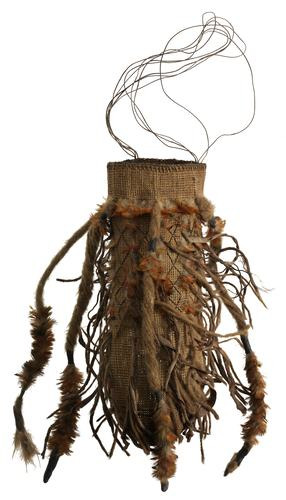
A Dhalwangu basket or ‘bathi mindjalpi’ from Yolŋu Country/Arnhem Bay made of pandanus fibre, possum fur, parrot feathers, resin, plant fibre string, and cloth (x)

A bark water holder from palawa/ trawulwai (??) Country/Flinders Island. A coiled reed basket from Wadjaling, Wadjalad, Wadjabangai, and Pitjara Country/Tambo. And a paperbark coolamon from Western New South Wales (x)

A Jawun/small basket made of plant fibre, plant fibre string and red ochre. I can’t find who or which Country it belongs to but its from the South Australian Museum (x)

An eel trap basket from Gunditjmara Country - Tae Rak/Lake Condah (x)

A shell head band made of nautilus shell and bark-fibre string from Guugu Yimithirr Country, near Cooktown (x)
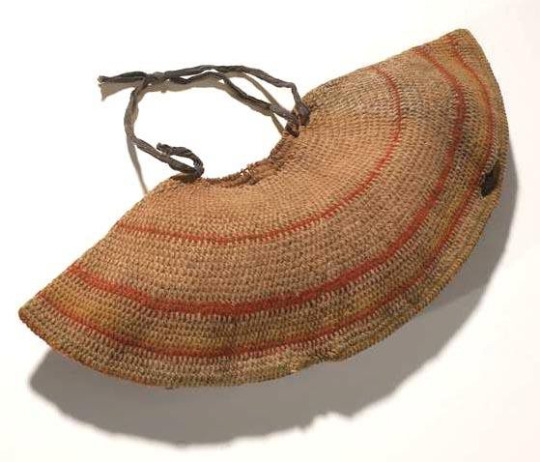
A dilly bag made of woollen blanket thread and ochre coating from Boulia/Pitta Pitta, Kalkadoon, Yulluna, Yalarrnga, Bularnu Waluwarra Wangkayuju, and Wangkamahdla Country - admittedly its partially woolen thread but look how cool it looks (x)

A cane and twine wallaby trap from Wadjanbarra Yidi Country/Atherton (x)
Also more detailed images of weaving provided to Community by the South Australia Museum are HERE but theres too many of them and i cant choose just ONE so go look at them all im in awe of them
also an honourary mention to the Ghost Net Art from Erub Erwer Meta because theyre ridiculously cool

43 notes
·
View notes
Text
Abolish police; abolish prisons
Thoughts from the settler colony, ‘Australia’; I’m an Indigenous (Guugu Yimithirr) criminal defence lawyer who represents Indigenous people. Had to get some thoughts out after a hard few weeks at work and everything that is going on in the USA and here in solidarity/response.
It is possible to imagine a world without police and a world without prisons. And it is precisely that world that we should be moving towards.
Police do not make us safer and prisons are criminogenic - they compound the various social factors which produce crime ... leading to more trauma; more poverty; more crime; more police; more prisons.
Imagine what our world would look like if we did the work of caring for each other instead of policing and incarcerating each other. So many of my clients want and need stable housing; they want and need support for their chronic mental and physical health issues; they want and need support in managing the multiplicities of traumas they have experienced so that they don't need to rely on maladaptive coping strategies like substance use to survive. Instead, they are often incarcerated and further traumatised. When they are released, it is often without adequate support. They are then punished harshly if they re-offend.
It's not an economic question, but it costs about $110,000 to incarcerate one person for one year.* Again, it's not an economic question, but imagine if we directed the over $4.6 billion dollars we spend on prisons every year to social services.*
To re-iterate, it's not an economic question. It's about trying to move away from a system we know does not work. We know that police and prisons are not safe for so many people in our communities (e.g. for Indigenous, Black, POC, mentally ill, disabled people, poor people, queer people, and many more).
A world without police and prisons is a world in which we do not allow social problems to fall on individuals - and we do not allow those social problems to endlessly replicate.
The systems of policing and prisons are not capable of reform. I’m not interested in reform. They are systems that have their origins in racist, colonialist, and classist ideologies; they have always been about protecting the comfort, property, and interests of the elite. Why try to reform that?
If you don’t know where to start reading about policing and prison abolition, a good place to start is Critical Resistance’s page on abolishing policing.
*I’m writing from the settler colony, Australia. These were the costs in 2015, and 2017-2018.
#prison abolition#policing#auspol#Indigenous politics#prisons#australia#abolish the police#racism#abolition
501 notes
·
View notes
Text
Plural of Kangaroo: Correct Term and Usage
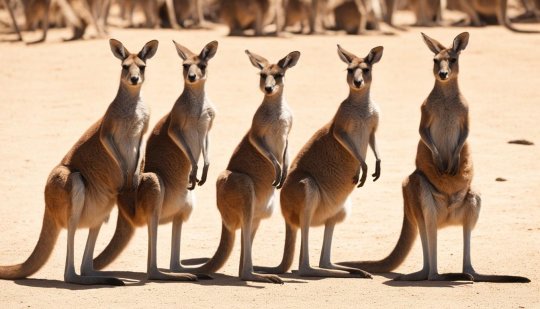
Kangaroos, a symbol of Australia's unique wildlife, are not only fascinating marsupials but also a subject of linguistic interest. The word 'kangaroo' is commonly used globally, often evoking images of these hopping animals carrying their joeys in pouches. This article delves into the intricacies of the word 'kangaroo,' focusing on its plural form and usage, providing a comprehensive understanding for language learners and enthusiasts.
The Singular and Plural of Kangaroo
Singular: KangarooPlural: Kangaroos
The transformation from singular to plural for 'kangaroo' follows a straightforward rule in English grammar where the addition of an 's' at the end of the word denotes more than one. Hence, when referring to multiple such animals, the term 'kangaroos' is used.
Understanding Kangaroo
Definition of Kangaroo
A kangaroo is a large marsupial from the family Macropodidae, primarily found in Australia. Kangaroos are known for their powerful hind legs, large feet, and a strong tail used for balance. They are distinctive for their method of locomotion: hopping.
Usage of Kangaroo
The word 'kangaroo' has transcended its zoological reference to become a cultural icon, representing various aspects of Australian identity and folklore. It appears in sports mascots, logos, and Australian colloquialisms.
Use of Kangaroo in Sentences
- Singular Usage: "A lone kangaroo was spotted hopping across the outback at sunset."
- Plural Usage: "A group of kangaroos gathered near the watering hole is a common sight in rural Australia."
- Descriptive: "The kangaroo, with its powerful hind legs, can leap over obstacles with ease."
- Cultural Reference: "The kangaroo is an emblematic figure in Australian sports, often used as a mascot."
- Colloquial Usage: "In Australian slang, 'kangaroo' is sometimes shortened to 'roo'."
Common Mistakes and Confusions
- Kangaroos vs. Kangaroo's: 'Kangaroos' refers to more than one kangaroo, while 'kangaroo's' is possessive, indicating something belongs to a kangaroo.
- Miscounting: Mistakingly using 'kangaroo' when referring to multiple animals.
- Cultural Misunderstanding: Overlooking the cultural significance of the kangaroo in Australian context.
Commonly Asked Questions
- Q: Can 'kangaroos' be used to refer to a mixed group of adult and baby kangaroos?A: Yes, 'kangaroos' can include both adult and juvenile kangaroos, though the young are often specifically called 'joeys'.
- Q: Is there a historical or Aboriginal origin to the word 'kangaroo'?A: Yes, the word 'kangaroo' is believed to have originated from the Guugu Yimithirr word 'gangurru', referring to a specific species of kangaroo.
Conclusion
Understanding the plural form of 'kangaroo' enriches one’s linguistic repertoire and offers a glimpse into Australian culture and wildlife. The transition from 'kangaroo' to 'kangaroos' is a simple yet significant aspect of English grammar, reflecting the language's capacity to adapt and evolve. Remember, whether it's one kangaroo hopping across the outback or a group of kangaroos, the correct usage is essential in both speech and writing.
FAQ
What is the plural of kangaroo?
The correct term for the plural of kangaroo is "kangaroos."
How do you form the plural of nouns in English?
Most nouns add an "s" to form the plural. Nouns ending in "s," "sh," "ch," "x," or "z" add "es." Nouns ending in "o" can add either "s" or "es." Nouns ending in "o" add "s." Nouns ending in "y" change the "y" to "i" and add "es." Nouns ending in "y" simply add an "s." Nouns ending in "f" or "fe" can have irregular plurals.
Why is there confusion over the plural of kangaroo?
The confusion over the plural of kangaroo arises because the rules for forming plurals with nouns ending in "o" can be unpredictable. While most nouns ending in "o" simply add an "s" or "es," "kangaroo" follows the standard rule and always forms its plural as "kangaroos."
How can I ensure language accuracy when forming plurals?
Understanding the correct plurals of nouns, such as the plural of kangaroo, is essential for effective communication. By following the standard rules for forming plurals and learning the plurals of irregular nouns, you can ensure that your language is accurate and precise. Avoid using apostrophes to form plurals, as this is never the correct approach.
Read the full article
0 notes
Note
Aphantasia anon: I honestly don’t know for the ADHD / Autistic thing. Maybe I’m one of them. Maybe I’m not. Maybe it’s just trauma making it seems like one of them. It’s hard to tell. I do zone out and daydream though I don’t visualize things. It’s just me thinking about something then jumping on another subject and doing it again and again until I forget my surroundings. I dream though I don’t remember what it was almost all the time. For reading m I didn’t particularly struggle with figures of
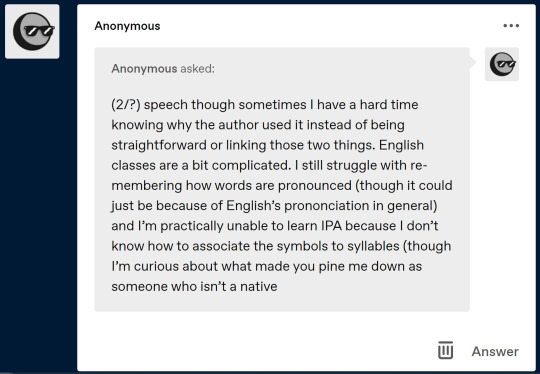
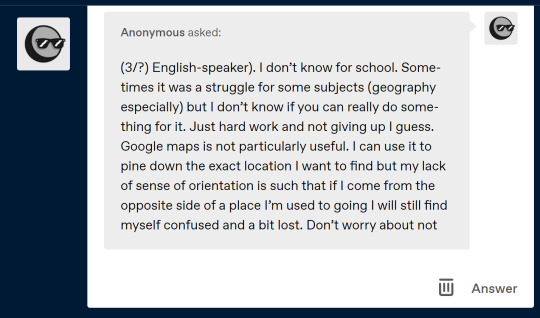
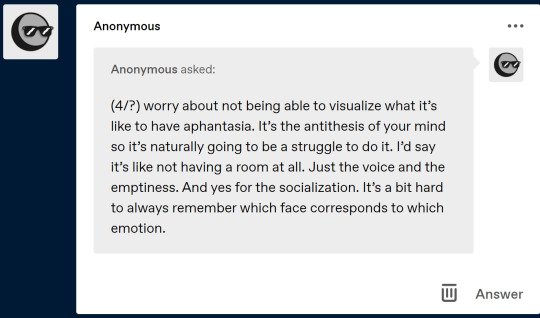
SOk sorry this took me so long to get to, I didn't have much time to like actually sit down and reply today instead of mindlessly scrolling Tumblr and reblogging with pithy responses. :P
So, I can tell you that trauma and ADHD do feel different. Like I have trauma responses caused by how people treated me bc of the ADHD and they aren't really the same thing. So idk, if you have the symptoms of something like that it might be worth having it checked out.
It's awesome that you still can daydream hard enough to get lost in your own brain even if you aren't seeing pictures. Makes me wonder about what the function of daydreaming is in general, cause even tho your sensory experiences are totally different you still do this thing.
Heh I literally didn't even know what IPA was till you said that and I googled it and it doesn't look easy to learn so I don't blame you. And I didn't have any idea that English wasn't your first language, I just didn't want to make assumptions bc I was asking about school and I don't know what English class is like or if it exists in other places. Like I took a language for 4 years in school, but it was very different than my English classes. It taught us the language from zero, whereas with English all of the vocab and parts of speech stuff happens at earlier grades (and just in regular day to day life obviously.) and by the time you get to be like 14-18 years old it's a lot of literature, poetry, etc.
So re: google maps. Is it just the maps themselves that aren't helpful, or do you still struggle even if it's the turn-by-turn like vocally telling you "hey, make a left up here"? I kinda wonder...in Queensland, Australia there's an aboriginal people that speak Guugu Yimithirr. Instead of using up, down, left, and right they always use North, South, East, and West. I wonder if that kind of directional thinking would be helpful to you in navigating because you'd be able to navigate by knowing what direction something is in general rather than trying to picture where it is in relationship to yourself.
So the face/emotion thing is actually often true for ND people as well. I guess that's one thing our brains have in common! =D Honestly friend, your brain sounds peaceful. I mean I like mine but sometimes it would be nice to just be able to close my brain's eyes too. Wait, have you ever meditated? What's that experience like?
1 note
·
View note